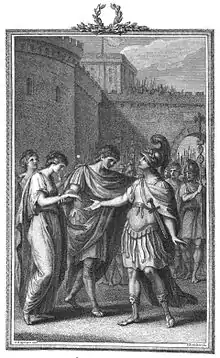Romolo ed Ersilia (Hasse)
Romolo ed Ersilia is a three-act opera composed by Johann Adolph Hasse to an Italian-language libretto by Pietro Metastasio. The opera was commissioned by Empress Maria Theresa to celebrate the marriage of her son Leopold to Maria Luisa of Spain. The opera was first performed on 6 August 1765, the day after their wedding, in the court theatre of the Imperial Palace in Innsbruck.[1][2] The opera received its first performance in modern times in 2011 during the Innsbruck Festival of Early Music.[3]
| Romolo ed Ersilia | |
|---|---|
| Opera by Johann Adolph Hasse | |
 Illustration of the opera's final scene from a 1781 copy of the libretto | |
| Librettist | Pietro Metastasio |
| Premiere | |
The opera is loosely based on The Rape of the Sabine Women, an episode in the legendary history of Rome, traditionally dated to 750 BC. The opera's main protagonists are Romolo (Romulus, the founder and ruler of Rome) and Ersilia (Hersilia, who became the wife of Romulus).
The same libretto was set eight years later by Josef Mysliveček and again titled Romolo ed Ersilia. The libretto also formed the basis for a 1780 ballet d'action choreographed by Charles Le Picq to music by Martín y Soler and entitled Il ratto delle Sabine.[4] An opera entitled Romolo ed Ersilia is the opera seria which is parodied as the "opera within an opera" in Donizetti's Le convenienze ed inconvenienze teatrali.[5]
Roles
| Role | Voice type[lower-alpha 1] | Premiere cast, 6 August 1765 |
|---|---|---|
| Romolo (Romulus), the king and founder of Rome | castrato | Gaetano Guadagni |
| Ersilia, Hersilia, a Sabine princess bethrothed to Romolo | soprano | Anna de Amicis |
| Curzio, Sabine king and Ersilia's father | tenor | Domenico Panzacchi |
| Acronte, a Sabine prince and rejected suitor of Ersilia | castrato | Gaspare Pacchierotti |
| Valeria, a Roman noblewoman betrothed to Acronte but abandoned by him | soprano | Teresa Dupré née Sartori |
| Ostilio, Romolo's friend, in love with Valeria | castrato | Luca Fabbris |
| The people of Rome | ||
Notes
- In the modern revival the male castrato roles were sung by women, mezzo-sopranos for Romolo and Acronte and a soprano for Ostilio.[3]
References
- Howard, Patricia (2014). The Modern Castrato: Gaetano Guadagni and the Coming of a New Operatic Age. p. 108. Oxford University Press. ISBN 0199365210
- Lavezzi, Gianfranca (ed.) (2010). Pietro Metastasio: Melodrammi e arie, p. 55 (digital edition). BUR/Rizzoli. ISBN 8858614186
- Innsbruck Festival of Early Music Opera Archives. Romolo ed Ersilia
- DelDonna, Anthony R. (2016). Opera, Theatrical Culture and Society in Late Eighteenth-Century Naples, pp. 240–241. Routledge. ISBN 1317085396
- "Buxton Opera House and Pavilion Arts Centre". Archived from the original on 26 July 2022. Retrieved 26 July 2022.
External links
- Libretto (published in Rome, 1765)
- Manuscript score (on archive.org)